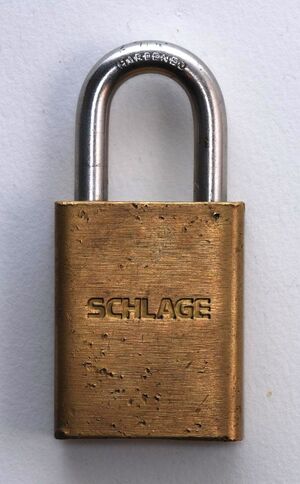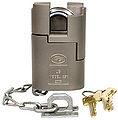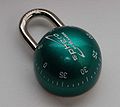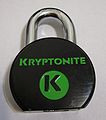Padlock: Difference between revisions
m (hi shear link) |
|||
| (5 intermediate revisions by 3 users not shown) | |||
| Line 8: | Line 8: | ||
A '''padlock''' is a portable [[lock]] used to restrict access to an area or enclosure or prevent an object from being removed from an area. Padlocks are widely used in everyday life in both low and high security installations. In popular use, padlocks are used on lockers, gates, fences, hasps, and chains to secure a wide variety of objects and areas. | A '''padlock''' is a portable [[lock]] used to restrict access to an area or enclosure or prevent an object from being removed from an area. Padlocks are widely used in everyday life in both low and high security installations. In popular use, padlocks are used on lockers, gates, fences, hasps, and chains to secure a wide variety of objects and areas. | ||
Padlocks can use a variety of locking designs, but [[pin-tumbler]] and [[warded]] mechanisms are the most common. [[Lever]] padlocks were also popular at one time, but use has dwindled in most parts of the world in favor of pin-tumbler or warded mechanisms. | Padlocks can use a variety of locking designs, but [[Pin_tumbler|pin-tumbler]] and [[warded]] mechanisms are the most common. [[Lever]] padlocks were also popular at one time, but use has dwindled in most parts of the world in favor of pin-tumbler or warded mechanisms. | ||
__TOC__ | __TOC__ | ||
<br clear=all> | |||
== History == | == History == | ||
The earliest padlocks were from the Roman era, from 500 BC to 300 AD. | The earliest padlocks were from the Roman era, from 500 BC to 300 AD. | ||
| Line 28: | Line 29: | ||
;''locking mechanism'' | ;''locking mechanism'' | ||
:The component that restricts the shackle until the correct [[key]] or [[combination]] is used. Modern padlocks do not interface directly with the shackle but instead use an [[actuator]] to do so. [[Pin-tumbler]] and [[warded]] locking mechanisms are the most popular on padlocks worldwide. Many padlocks use locking designs that provide a [[key retaining]] mechanism. | :The component that restricts the shackle until the correct [[key]] or [[combination]] is used. Modern padlocks do not interface directly with the shackle but instead use an [[actuator]] to do so. [[Pin_tumbler|Pin-tumbler]] and [[warded]] locking mechanisms are the most popular on padlocks worldwide. Many padlocks use locking designs that provide a [[key retaining]] mechanism. | ||
;''shroud'' | ;''shroud'' | ||
| Line 38: | Line 39: | ||
<div align="center"><gallery> | <div align="center"><gallery> | ||
File:Clear padlock front-Reinder.png | Clear acrylic practice lock | |||
File:Yale HSS50 dimple padlock.jpg|[[Yale]] HSS50 dimple padlock. | File:Yale HSS50 dimple padlock.jpg|[[Yale]] HSS50 dimple padlock. | ||
File:Slaymaker rustless padlock.jpg|Slaymaker rustless padlock. | File:Slaymaker rustless padlock.jpg|Slaymaker rustless padlock. | ||
| Line 43: | Line 45: | ||
File:Brinks shrouded padlock.jpg|A shrouded [[Brinks]] brand padlock. | File:Brinks shrouded padlock.jpg|A shrouded [[Brinks]] brand padlock. | ||
File:BEST SFIC padlock.jpg|BEST SFIC padlock. | File:BEST SFIC padlock.jpg|BEST SFIC padlock. | ||
File:American 1105 padlock.jpg|American 1105 padlock. | File:American 1105 padlock.jpg|[[American Lock]] 1105 padlock. | ||
File:American 700 padlock.jpg|American 700 padlock. | File:American 700 padlock.jpg|[[American Lock]] 700 padlock. | ||
File:ABUS Plus 88 50 padlock.jpg|The [[ABUS Plus]] padlock. | File:ABUS Plus 88 50 padlock.jpg|The [[ABUS_Plus_88/50|ABUS Plus 88/50]] padlock. | ||
File:S&G 951C.jpg|[[Sargent and Greenleaf]] 951C shrouded high-security padlock. | File:S&G 951C.jpg|[[Sargent and Greenleaf]] 951C shrouded high-security padlock. | ||
File:Lock_Sphero.jpg|[[Master Lock Sphero]] combination padlock. | |||
File:Ingersoll_CS700_cylinder_disassembled.jpg|The [[Ingersoll CS700]] padlock. | |||
File:Abus-160_40.jpg|[[ABUS 160]] padlock. | |||
File:Tri-circle_264.jpeg | [[Tri-Circle 264]] padlock | |||
File:Hi-Shear_LK1200_padlock.jpg|[[Hi-Shear_LK_1200 |Hi-Shear LK 1200]] padlock. | |||
File:SG_8088_padlock.jpg|[[S&G 8088]] padlock. | |||
File:MasterLock_SpeedDial_lock.jpg|[[Master Lock]] [[Speed Dial]] padlock. | |||
File:Abus_155_padlock.jpg|[[ABUS 155]] combination padlock. | |||
File:Abus_85-40.jpg|[[ABUS 85]] padlock. | |||
File:Kryptonite_padlock.jpg|[[Kryptonite 851219]] padlock. | |||
</gallery></div> | </gallery></div> | ||
== See also == | == See also == | ||
* [[Combination]] | |||
* [[Cylinder]] | |||
* [[Lock]] | * [[Lock]] | ||
* [[Bolt]] | * [[Bolt]] | ||
[[Category:Locks]] | [[Category:Locks]][[Category:Padlocks]] | ||
Latest revision as of 23:34, 15 January 2023
Padlock
| This article may require cleanup to meet Lockwiki's quality standards. Please improve this article if you can. |

A padlock is a portable lock used to restrict access to an area or enclosure or prevent an object from being removed from an area. Padlocks are widely used in everyday life in both low and high security installations. In popular use, padlocks are used on lockers, gates, fences, hasps, and chains to secure a wide variety of objects and areas.
Padlocks can use a variety of locking designs, but pin-tumbler and warded mechanisms are the most common. Lever padlocks were also popular at one time, but use has dwindled in most parts of the world in favor of pin-tumbler or warded mechanisms.
History
The earliest padlocks were from the Roman era, from 500 BC to 300 AD.
Through the last several hundred years, padlocks have become far more advanced than their earlier ancestors. Whereas many of the earlier padlocks were little more than poorly wrought designs that could be bypassed easily, today we have padlocks that incorporate high-security cylinders, restricted keyways, high-strength materials and components, and ever more advanced measures of security. For instance, some of the padlocks manufactured by Sargent and Greenleaf incorporate ceramic plates into the body of the lock, providing increased protection against attacks from drilling and freezing the lock body to extreme temperatures.
Most padlocks share a common design theme. An upside-down U-shaped shackle and a rectangular body. This common design has spread in use to indicate a secure connection on a website, with a symbol of a locked padlock in the status bar of a web browser.
Parts of a padlock
- shackle, bolt
- A rod made of a hardened material (typically steel) that is affixed to an object, usually a hasp, fence, or chain. The shackle is responsible for keeping the padlock connected to whatever it is attached to. This is the weakest part of the padlock in forced entry as the unprotected bolts can often be cut using bolt cutters. See bolt for more information.
- body
- The part of the padlock that surrounds the locking mechanism and most of the shackle. More secure padlocks attempt to conceal as much of the shackle as is possible to prevent various forms of forced entry. Padlocks designed in this manner are referred to as shrouded.
- locking mechanism
- The component that restricts the shackle until the correct key or combination is used. Modern padlocks do not interface directly with the shackle but instead use an actuator to do so. Pin-tumbler and warded locking mechanisms are the most popular on padlocks worldwide. Many padlocks use locking designs that provide a key retaining mechanism.
- shroud
- The portion of a padlock body that covers or conceals the shackle or bolt. Padlocks that use a shroud are referred to as "shrouded" and help defend against certain forms of destructive entry.
Gallery
Yale HSS50 dimple padlock.
Common Master Lock padlock.
A shrouded Brinks brand padlock.
American Lock 1105 padlock.
American Lock 700 padlock.
The ABUS Plus 88/50 padlock.
Sargent and Greenleaf 951C shrouded high-security padlock.
Master Lock Sphero combination padlock.
The Ingersoll CS700 padlock.
ABUS 160 padlock.
Tri-Circle 264 padlock
Hi-Shear LK 1200 padlock.
S&G 8088 padlock.
Master Lock Speed Dial padlock.
ABUS 155 combination padlock.
ABUS 85 padlock.
Kryptonite 851219 padlock.



















